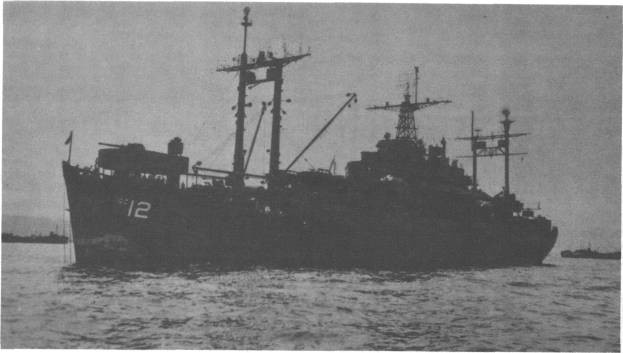
A mountain peak and national park in Colorado.
Estes (AGC-12) was launched 1 November 1943 by North Carolina Shipbuilding Co., Wilmington, N.C., as Morning Star;acquired by the Navy 22 February 1944; and commissioned 9 October 1944, Commander R. 0. Mathews in command.
On 20 November 1944 Estes arrived at Pearl Harbor from Norfolk, and after training, broke the flag of Rear Admiral W. H. P. Blandy, Commander, Amphibious Group One. She sailed from Pearl Harbor 10 January 1945 for rehearsal landings in the Marianas, and on 16 February arrived off Iwo Jima. As flagship for TF 52, Estes served as control center for the pre-invasion bombardment, and the work of underwater demolition teams preparing the beaches for the assault. She remained off the island through the landings of the 19th, receiving wounded and supplying and repairing small craft. She arrived at Ulithi 11 March to make final preparations for the Okinawa assault.
Again flagship for TF 52, the amphibious support force, Estes was off Okinawa 24 March 1945. She landed an underwater demolition group, then sailed with the bombardment group, directing the preinvasion pounding of the beaches and Japanese strong points. Using information gained from her contacts with the radar picket destroyers, she controlled carrier planes protecting the vast concentration of shipping assembled for the assault on 1 April. After almost a month off the bitterly contested island, she sailed 20 April to replenish at Saipan and carry Admiral Blandy to Pearl Harbor, where he and his staff disembarked 19 May.
Estes continued to San Francisco for overhaul, and equipment installation designed to make her even more effective. On 20 July, she embarked Rear Admiral R. O. Davis, Commander, Amphibious Group 13, and on 8 August sailed for the Philippines. She arrived at Leyte 28 August for occupation duty, coordinating the lifting of troops from the Philippines to Japan. After cruising widely in the Philippines on this duty, Estes sailed for Shanghai, and upon her arrival 7 November, broke the flag of Admiral T. C. Kinkaid, Commander, 7th Fleet Before she had completed her tour of occupation duty along the Chinese coast, for part of which she was homeported at Tsingtao, she served as flagship for three succeeding commanders of the 7th Fleet, Vice Admiral D. E. Barbey, Admiral C. M. Cooke and Admiral O. C. Badger. In June 1946 Estes became flagship for Naval Forces, Western Pacific, and continued to cruise between Tsingtao and Hong Kong, aside from a 1947 overhaul at Bremerton, until 29 January 1948, when she departed Tsingtao for San Francisco. Arriving 16 February, she lay at San Francisco and San Diego until decommissioned and placed in reserve 30 June 1949.
Estes recommissioned 31 January 1951, and after training off San Diego, sailed 20 June for Yokosuka and Inchon, where from 25 July to 6 August, she served as flagship for Vice Admiral I. N. Kiland, Commander, Amphibious Force, Pacific. She carried successive Commanders, Amphibious Group One, through the remainder of this tour of duty in the Far East, during which she operated off Korea and in exercises off Japan.
Returning to San Diego 19 April 1952, Estes carried high-ranking observers to the Marshall Islands for nuclear weapons tests in the fall of 1952, and in the summer of 1953, served as flagship for an expedition to supply Government activities in the Arctic. Between January and May 1954, she again sailed for atomic weapons tests at Eniwetok, and on 6 July cleared for the Far East. As control ship for Operation "Passage to Freedom," the evacuation of refugees from Communist North Vietnam, Estes operated from Haiphong 18 August to 29 October. Between 6 and 11 February 1955 she joined in another outstanding illustration of the Navy's ability to aid freedom-loving people when she operated in the evacuation of the Tachen Islands.
Estes returned to San Diego 22 May 1955. She operated out of there for the next year. Between March and July 1956, she was again in the Marshalls for weapons tests, and on 31 January 1957 sailed for Yokosuka, where she provided quarters and communications facilities until April, sailing then to visit Hong Kong. She returned to stateside duty 15 May, voyaging to Pearl Harbor in July and August.
The next year found Estes sailing north in July to ports in British Columbia, and again in August to call at Seattle. During her 1959 tour of duty in the Far East she directed important amphibious operations offJapan, Okinawa, and Korea, and exercises off Borneo with ships of the Royal Navy and Royal New Zealand Navy. She returned to Long Beach in August, and through 1962 operated along the west coast, twice visiting the Pacific Northwest.
Estes received two battle stars for World War II service, and two for Korean war service.


